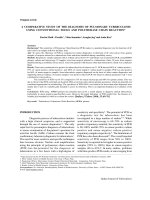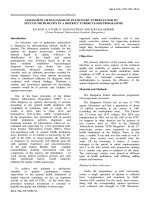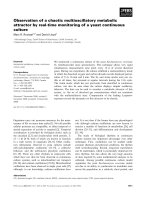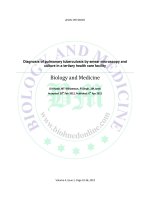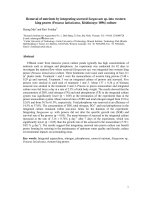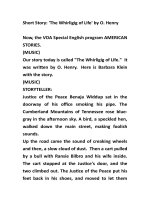Diagnosis of paratuberculosis by fecal culture followed by nested-polymerase chain reaction
Bạn đang xem bản rút gọn của tài liệu. Xem và tải ngay bản đầy đủ của tài liệu tại đây (411.87 KB, 8 trang )
Int.J.Curr.Microbiol.App.Sci (2020) 9(5): 1731-1738
International Journal of Current Microbiology and Applied Sciences
ISSN: 2319-7706 Volume 9 Number 5 (2020)
Journal homepage:
Original Research Article
/>
Diagnosis of Paratuberculosis by Fecal Culture Followed
by Nested-Polymerase Chain Reaction
Anand Mohan*, P. Das and N. Kushwaha
Biological Product Division, Indian Veterinary Research Institute, Izatnagar, India
*Corresponding author
ABSTRACT
Keywords
Mycobacterium
avium subspecies
paratuberculosis,
Nested-PCR, ZiehlNeelsen staining
Article Info
Accepted:
15 April 2020
Available Online:
10 May 2020
Culture of clinical samples is the confirmatory test for the diagnosis of paratuberculosis
but, it is time consuming due to its long incubation period, further it requires a skilled
personnel to monitor the growth. Use of molecular techniques such as PCR is
advantageous over the long incubation period in culturing of samples; more than eight
months of incubation is needed to declare a sample to be negative. Two cattle farms
(Cattle rehabilitation center and organized dairy farm) with different organizational setup
were screened by culture of fecal samples. Ziehl-Neelsen (ZN) staining and nested-PCR
were implied to confirm the growths on these samples after two months of inoculation on
Herrold’s Egg Yolk Medium (HYM). Overall, 33.67% samples confirmed the growth of
Map bacilli and 25.00% samples confirmed the growth of acid-fast bacilli. In cattle
rehabilitation center 50.00% samples confirmed the growth of Map bacilli and 35.63%
shown to have acid-fast bacilli, whereas in the organized dairy farm it was 15.00% and
13.57%, respectively. Confirmation of growth of bacilli in samples belongs to age groups
0 - < 3 yrs and 3 - < 6 yrs were indicated, approximately same level of infection (2;
p>0.05), but significantly higher level of infection were confirmed in age group of ≥ 6 yrs
(2; p<0.05). Appreciable colonies were identified after the incubation of 7 to 9 months on
cultures positive in both ZN stain and nested-PCR, but cultures negative in nested-PCR
were failed to produce colonies even after incubation of one year. Study confirmed that
variation in level of paratuberculosis in these two cattle farm with possible organizational
set up influences. Present study concludes that, use of nested-PCR in conjunction with
fecal culture reduce long incubation period to confirm Map bacilli and high percentage of
paratuberculosis positive animals in old age group in both farms.
Introduction
Mycobacterium
avium
subspecies
paratuberculosis (Map) causes chronic,
granulomatous enteritis of ruminants, known
as paratuberculosis or Johne’s disease. Host
acquires infection in early life via feco-oral
route through the ingestion of contaminated
colostrums, milk, water, or feed (Sweeney,
1996) and also possibly through intrauterine
route (Seitz et al., 1989). Disease can persist
for several years in a subclinical phase
without showing any clinical signs. However,
once the disease enters the clinical phase, the
wall of intestine get thickened which leads to
diarrhea, weight loss, decreased milk
1731
Int.J.Curr.Microbiol.App.Sci (2020) 9(5): 1731-1738
production and eventual death (Hasonova and
Pavlik, 2006). Disease can be diagnosed by
detection of viable bacilli (culture), genome
(PCR), host immune response (Harris and
Barletta, 2001), etc. Antibody detection
techniques
such
as
enzyme-linked
immunosorbent assay (ELISA) are commonly
used diagnostics (Collins et al., 2005).
However, host humoral immune response to
bacilli is delayed and techniques which rely
on humoral response are to be used in
advanced stage of infection. Meantime,
infected animals may contaminate the
environment or pass infection to other
susceptible animals. Culture of Map is
considered as gold standard and confirmatory
diagnosis of paratuberculosis, but is time
consuming and requires 8 to 16 weeks of
incubation. The application of molecular
techniques in conjunction with culture may
hasten the diagnostic procedure. PCR is most
common and widely used molecular
technique and has been adopted in different
format. PCR using insertion sequence IS900
has been routinely used to detect the Map
genome but, similarities with other
mycobacterium, particularly Maa (97% DNA
homology)
decreases
its
specificity.
Furthermore, sequences related to IS900 have
also been identified in Wood pigeon
mycobacterium (IS902), M. intracellulare
(IS1626) and Maa (IS901 and IS1626).
Therefore a positive IS900 should be
confirmed by subsequent nested-PCR or by a
PCR assay targeting another gene or sequence
in Map genome.
Present study was designed to investigate the
level of infection in two different cattle
population with culture followed by ZN
staining and nested-PCR for confirmation of
disease. IS900 and f57 sequences have been
used as complementary to each other in
nested format to ascertain the Map bacilli.
Results were also being compared with test
Nested-PCR and ZN staining which was
performed before culture of samples on
HYM.
Materials and Methods
Animal population and sample collection
Fecal samples were collected directly from
rectum of animals and kept in plastic bag; a
cold chain was maintained till the samples
were processed. Two cattle farms were
chosen; one was unproductive cattle
rehabilitation center i.e. Gaushala (Barsana,
Mathura, Uttar Pradesh) which maintains
unproductive, orphan, discarded animals. A
total of 160 sick cattle with the history of
chronic diarrhea and ill health, were selected
for sample collection. Another was
instructional cattle dairy farm, Pantnagar
(Uttarakhand), maintains the animals for milk
production. Here samples were collected from
140 cattle without given preference to sick
animals. Details of fecal samples collected
with respect to age are mentioned in table 1.
Processing and Culture of fecal samples
Fecal samples were decontaminated in 0.75%
(W/V) Hexadecylpyridium chloride (HPC) to
remove contaminant microorganism (OIE
Terrestrial Manual, 2008). Decontaminated
sediment (100 µl) was inoculated on
Herrold’s Egg Yolk Medium (HYM)
containing mycobactin-J (2 µg/ml) in
duplicates. HYM was prepared according to
the composition mentioned in OIE Terrestrial
manual (2008) and was modified with
addition of chloramphenicol (50 µg/ml),
penicillin (100 U/ml) and amphotericin-B (50
µg/ml). The slants were incubated at 37°C at
least for 4 months with regular observation.
Any visible growth was confirmed by ZN
staining, followed by nested-PCR. Slants
which did not give positive results with PCR
even after four month of incubation declared
Map negative, but observed up to 1 year.
1732
Int.J.Curr.Microbiol.App.Sci (2020) 9(5): 1731-1738
Confirmation of Map by nested-PCR
Slants with suspected growth of ≥ 2 months
old were taken for genomic DNA isolation as
well as ZN staining. Methods described by
Kauppinen et al., (1994) were followed with
suitable modifications for DNA isolation.
Confirmation of Map bacilli was done based
on presence of IS900 and f57 sequence.
Primer pairs, PCR reaction compositions,
thermocyclic and electrophoretic conditions
were followed as prescribed by Vansnick et
al., (2004). Briefly, all samples were screened
for IS900 insertion sequence which
corresponds to 572bp amplicon. Positive
amplicons were again amplified with different
internal primer pair which corresponds to
452bp amplicons (Nested-PCR). Samples
which were positive in both amplification of
IS900 were again screened for presence of f57
sequence in same way as IS900. Amplicons
of 432bp and 424bp respectively in first and
second amplification for f57 sequence were
expected in positive cases. Samples which
had given all four amplicons of IS900 and f57
were designated as positive otherwise
declared negative for Map.
Results and Discussion
Cultures of fecal samples were weekly
monitored
for
any
growth
and
contaminations. As contamination was the
main complication (Nielsen et al., 2004) in
the initial few weeks of incubation but it was
resolved by subculture to new slant.
Contamination requires more attention since
tubes need to be incubated for longer
duration. Typical colonial morphology of
Map is difficult to identify particularly in
primary isolation, however small (1 mm
diameter),
colorless,
translucent,
hemispherical, smooth and glistening colony
would be expected after 8 weeks of growth
(Sevilla et al., 2007). Most of tubes didn’t
show any appreciable growth at two month of
incubation. Slow growth of Map in primary
culture and adaptation on artificial media
retard its multiplication. More than 25 hrs
(Thorel et al., 1990) is required to complete a
multiplication cycle, even though 1.2 days to
10 days generation time have also been
estimated (Elguezabal et al., 2011). Some of
tubes had minute transparent colonies after
the incubation of 7 to 9 months (Figure 1A
and 1B). Standard laboratory working on Map
suggests; colonies are appreciable any time
after 5 weeks to 6 months of incubation
(Gwozdz, 2010) in primary isolation and
recommends negative samples should not be
discarded without incubation of 6 to 8 months
(de Juan et al., 2006). Further, monitoring of
growth should be regular after 4 weeks of
incubation (Whipple et al., 1991). ZN stain
suggested growth of concern bacilli was
undergoing even they were not appreciated on
naked eye (Figure 2).
All tubes were screened by nested-PCR after
two month of inoculation. Primer pairs
correspond to IS900 and f57 sequences
separately were used in nested manner
(Vansnick et al., 2004). Preliminary screening
by ZN staining shown 25.00% samples
together from both farms had growth of acidfast bacilli (Table 1). However, confirmation
based on presence of IS900 and f57 sequences
(Figure 3) in nested-PCR revealed 33.67%
samples had Map bacilli. In individual farms,
acid-fast positive culture was 35.63% and
13.57%, respectively, in cattle rehabilitation
center and dairy farm. Confirmed cases of
Map in both farms were 50.00% and 15.00%,
respectively (Table 1). Although, level of
paratuberculosis in the places from where
these samples were collected, was 20 to 30%
(Mishra et al., 2009; Singh et al., 2010; Singh
et al., 2013). The way of sampling,
particularly from cattle rehabilitation center
was supposed to be the causal factor of high
level of paratuberculosis diagnosed. Farm
crowded with aged, discarded, apparently
1733
Int.J.Curr.Microbiol.App.Sci (2020) 9(5): 1731-1738
healthy and diseased animals make the
ground for high level of paratuberculosis in
cattle rehabilitation center. Crowding of
animals in small premises had also built the
ground for easy and rapid transmission of
infection
among
susceptible
hosts.
Continuous mixing of old and new animals in
farm might hasten the rate of infection. In
addition, nested-PCR is sensitive and specific
technique (Herthnek and Bolske, 2006; Wells
et al., 2006: Douarre et al., 2010) and hence
able to confirm the growth of bacilli on
culture which was incubated for ≥ 2 months.
Sub-normal level of bacilli may be enriched
during incubation of two months and might be
diagnosed as positive both in zn staining and
nested PCR. In contrary, organized dairy farm
had comparatively low level of infection; it
may be attributed to method of sample
collection (not biased toward the sick
animals) and organizational setup of the farm.
Growths confirmed by ZN staining/NestedPCR in age groups 0 - <3 yrs and 3 - <6 yrs
(Table 1) had approximately same level of
infection (2; p>0.05). This might be due to
small sample size. However, level of
paratuberculosis in advanced age group (≥6
yrs) was high (2; p<0.05). Similar conclusion
has also been given by Nielsen et al., (2013).
This could be explained as infection build up
in animals was cumulative due to long
incubation and was diagnosed only after
animals excrete bacilli in feces (Crossley et
al., 2005) or immune system response to
bacilli and both occur late in case of
paratuberculosis.
Table.1 Number of positive cases from two cattle farm with respect to age in different
diagnostics on fecal samples for paratuberculosis. Cattle rehabilitation center (Goshala, Barsana,
Mathura, Utter Predesh); Instructional cattle dairy farm (Pantnagar, Uttarkhand); aSamples
grown on HYM and stained after a fixed incubation period; bPCR was performed on culture
grown on HYM; P- No. of positive samples; T-Samples tested. Figure in parentheses indicate
percentage
Age
Unorganized farm
P (%)
T
Organized dairy farm
P (%)
Grand total
T
P (%)
T
ZN Staininga
0 - <3 yrs
10 (41.67)
24
2 (12.50)
16
12 (30.00)
40
3 - <6 yrs
8 (36.36)
22
9 (15.25)
59
17 (20.99)
81
≥6 yrs
39 (34.21)
114
8 (12.31)
65
47 (26.26)
179
Sub-total
57 (35.63)
160
19 (13.57)
140
75 (25.00)
300
16
59
65
140
17 (42.50)
20 (24.69)
64 (35.75)
101 (33.67)
40
81
179
300
Nested PCRb
0 - <3 yrs
3 - <6 yrs
≥6 yrs
Sub-total
15 (62.50)
12 (54.55)
53 (46.49)
80 (50.00)
24
22
114
160
2 (12.50)
8 (13.56)
11 (16.92)
21 (15.00)
1734
Int.J.Curr.Microbiol.App.Sci (2020) 9(5): 1731-1738
Figure.1 Growth of Map on HYM after A: 7 months and B: 9 months of incubation.
Figure.2 ZN stained bacilli which was incubated ≥ 2 months on HYM
Figure.3 Amplicons of A: IS900 and B: f57 sequences of Map from samples which was
incubated ≥ 2 months on HYM
1735
Int.J.Curr.Microbiol.App.Sci (2020) 9(5): 1731-1738
Nested-PCR with same primer pairs and ZN
staining has also been performed on fecal
samples (Mohan et al., 2013), but percentage
of positive samples diagnosed was low.
Several reasons could be postulated; one of
them was the organic matters of feces, which
could be interfered in DNA isolation, some of
them were identified as polymerase inhibitor
(Widjojoatmodjo et al., 1992). Host might
excrete sub-optimal level, erratic shedding of
bacilli; particularly in earlier stage of disease.
Decontamination procedure also reduced the
viable bacilli in clinical samples (Reddacliff
et al., 2003) significantly. Taking these in
consideration, culture was performed on
HYM, from decontaminated fecal samples. A
considerable number of negative samples in
each age group of animals from both farms
were diagnosed positive in respective tests
(Nested-PCR and ZN staining). Culture of
clinical samples is always confirmatory to
disease. In case of paratuberculosis, fecal
culture is routinely used and found superior to
other tests, even though it helps in calculating
the diagnostic efficiency of different
techniques (Martinson et al., 2008; Sharma et
al., 2008; Douarre et al., 2010; Sonawane and
Tripathi, 2013).
Present study concludes that nested-PCR
(IS900 and f57) used in conjunction with fecal
culture can be used to reduce the need of long
incubation for culture of samples on HYM.
Different organizational setup of farms might
be responsible for unusual level of
paratuberculosis diagnosed particularly in
cattle rehabilitation center but high percentage
of paratuberculosis positive animals in old
age group in both farms.
Acknowledgements
We are thankful to Dr. Ranbir Singh, Senior
Scientist, Animal Genetics Division, Indian
Veterinary Research Institute, Izatnagar-243
122 for helping in sample collection and
University Grant Commission/Indian Council
of Agricultural Research, New Delhi for
providing funds needed to carry out this work
successfully.
References
Collins, M. T., Wells, S. J., Petrini, K. R.,
Collins, J. E., Schultz, R. D. and
Whitlock, R. H. 2005. Evaluation of five
antibody detection tests for diagnosis of
bovine paratuberculosis. Clinical and
Diagnostic Laboratory Immunology. 12:
685-692.
Crossley, B. M., Zagmutt-Vergara, F. J., Fyock,
T. L., Whitlock, R. H. and Gardner, I. A.
2005. Fecal shedding of Mycobacterium
avium subsp. paratuberculosis by dairy
cows. Veterinary Microbiology. 107: 257263.
de Juan, L., Alvarez, J., Romero, B., Bezos, J.,
Castellanos, E., Aranaz, A., Mateos, A.
and Domínguez, L. 2006. Comparison of
four different culture media for isolation
and growth of type II and type I/III
Mycobacterium
avium
subsp.
paratuberculosis strains isolated from
cattle
and
goats.
Applied
and
Environmental Microbiology. 72: 59275932.
Douarre, P. E., Cashman, W., Buckley, J.,
Coffey, A. and O’Mahony, J. M. 2010.
Isolation and detection of Mycobacterium
avium subsp. paratuberculosis from cattle
in Ireland using both traditional culture
and molecular based methods. Gut
Pathogens. 2: 11. doi: 10.1186/17574749-2-11.
Elguezabal, N., Bastida, F., Sevilla, I. A.,
Gonzalez, N., Molina, E., Garrido, J. M.
and Juste, R. A. 2011. Estimation of
Mycobacterium
avium
subsp.
paratuberculosis Growth Parameters:
Strain Characterization and Comparison
of Methods. Applied and Environmental
Microbiology. 77: 8615-8624.
Gwozdz, J. M. 2010. Johne’s disease. In: OIE
and National Reference Laboratory for
1736
Int.J.Curr.Microbiol.App.Sci (2020) 9(5): 1731-1738
Johne’s
Disease,
Australia.
SubCommittee on Animal Health Laboratory
Standards.
/>uments/ANZSDP/Johnes_Disease_ANZS
DP_2010.pdf
Harris, L. P. and Barletta, R. G. 2001.
Mycobacterium
avium
subsp.
Paratuberculosis in veterinary medicine.
Clinical Microbiology Reviews. 14: 489512.
Hasonova, L. and Pavlik, I. 2006. Economic
impact of paratuberculosis in dairy cattle
herds: a review. Veterinarni Medicina.
51: 193-211.
Herthnek, D. and Bölske, G. 2006. New PCR
systems to confirm real-time PCR
detection of Mycobacterium avium subsp.
paratuberculosis. BMC Microbiology 6:
87. doi: 10.1186/1471-2180-6-87.
Kauppinen, J., Pelkonen, J. and Katila, M. L.
1994. RFLP analysis of Mycobacterium
malmoense strains using ribosomal RNA
gene probes: an additional tool to
examine intra species variation. Journal of
Microbiological Methods. 19: 261-267.
Martinson, S. A., Hanna, P. E., Ikede, B. O.,
Lewis, J. P., Miller, L. M., Keefe, G. P.
and McKenna, S. L. B. 2008. Comparison
of bacterial culture, histopathology, and
immunohistochemistry for the diagnosis
of Johne’s disease in culled dairy cows.
Journal
of
Veterinary
Diagnostic
Investigation. 20: 51-57.
Mishra, P., Singh, S. V., Bhatiya, A. K., Singh,
P. K., Singh, A. V. and Sohal, J. S. 2009.
Prevalence of bovine Johne’s disease
(BJD) and Mycobacterium avium
Subspecies paratuberculosis genotypes in
dairy cattle herds of Mathura district.
Indian
Journal
of
Comparative
Microbiology Immunology and Infectious
Disease. 30: 23-25.
Mohan, A., Das, P., Kushwaha, N., Karthik, K.
and Niranjan, A. K. 2013. Investigation
on the status of Johne's disease based on
agar gel immunodiffusion, Ziehl-Neelsen
staining and nested PCR approach in two
cattle farm. Veterinary World. 6: 778-
784.
Nielsen, S. S., Kolmos, B. and Christoffersen,
A. B. 2004. Comparison of contamination
and growth of Mycobacterium avium
subsp. paratuberculosis on two different
media. Journal of Applied Microbiology.
96: 149-153.
Nielsen, S. S., Toft, N. and Okura, H. 2013.
Dynamics
of
Specific
AntiMycobacterium
avium
Subsp.
paratuberculosis Antibody Response
through Age. PLoS One. 8: e63009.
doi:10.1371/journal.pone.0063009
Office International Epizootics (OIE). 2008.
Paratuberculosis
(Johne’s
disease).
Terrestrial Manual, Chapter 2.1.11. 276291.
Reddacliff, L. A., Vadali, A. and Whittington,
R. J. 2003. The effect of decontamination
protocols on the numbers of sheep strain
Mycobacterium
avium
subsp.
paratuberculosis isolated from tissues and
faeces. Veterinary Microbiology. 95: 271282.
Seitz, S. E., Heider, L. E., Heuston, W. D.,
Bech-Nielsen, S., Rings, D. M. and
Spangler, L. 1989. Bovine fetal infection
with Mycobacterium paratuberculosis.
Journal of the American Veterinary
Medical Association. 194: 1423-1426.
Sevilla, I., Garrido, J. M., Geijo, M. and Juste,
R.
A.
2007.
Pulsed-field
gel
electrophoresis profile homogeneity of
Mycobacterium
avium
subsp.
paratuberculosis isolates from cattle and
heterogeneity of those from sheep and
goats. BMC Microbiology. 7: 18. doi:
10.1186/1471-2180-7-18.
Sharma, G., Singh, S. V., Sevilla, I., Singh, A.
V., Whittington, R. J., Juste, R. A.,
Kumar, S., Gupta, V. K., Singh, P. K.,
Sohal, J. S. and Vihan, V. S. 2008.
Evaluation of indigenous milk ELISA
with m-culture and m-PCR for the
diagnosis of Bovine Johne’s disease
(BJD) in lactating Indian dairy cattle.
Research in Veterinary Science. 84: 3037.
Singh, A. V., Singh, S. V., Singh, P. K., Sohal,
1737
Int.J.Curr.Microbiol.App.Sci (2020) 9(5): 1731-1738
J. S. and Mahour, K. 2010. Serosurveillance of Mycobacterium avium
Subspecies Paratuberculosis Infection in
domestic livestock in North India using
indigenous absorbed ELISA test. Journal
of Advanced Laboratory Research in
Biology. 1: 1-4. ISSN 0976-7614.
Singh, S. V., Kumar, N., Chaubey, K. K.,
Gupta, S. and Rawat, K. D. 2013. Biopresence of Mycobacterium avium
subspecies paratuberculosis infection in
Indian
livestock
farms.
Research
Opinions in Animal and Veterinary
Sciences. 3: 401-106
Sonawane, G. G. and Tripathi, B. N. 2013.
Comparison of a quantitative real-time
polymerase chain reaction (qPCR) with
conventional PCR, bacterial culture and
ELISA for detection of Mycobacterium
avium subsp. paratuberculosis infection
in sheep showing pathology of Johne’s
disease. Spinger plus. 2: 45. doi:
10.1186/2193-1801-2-45.
Sweeney, R. W. 1996. Transmission of
paratuberculosis. Veterinary Clinics of
North America: Food Animal Practice.
12: 305-312.
Thorel, M. F., Krichevsky, M. and LevyFrebault, V. V. 1990. Numerical
taxonomy of mycobactin-dependent
mycobacteria, emended description of
Mycobacterium avium, and description of
Mycobacterium avium subsp. avium
subsp. nov., Mycobacterium avium subsp.
paratuberculosis subsp. nov., and
Mycobacterium avium subsp. silvaticum
subsp. nov. International Journal of
Systemic Bacteriology. 40: 254-260.
Vansnick, E., de Rijk, P., Vercammen, F.,
Geysen, D., Rigouts, L., Portaels, F.
2004. Newly developed primers for the
detection of Mycobacterium avium
subspecies paratuberculosis. Veterinary
Microbiology. 100: 197-204.
Wells, S. J., Collins, M. T., Faaberg, K. S.,
Wees, C., Tavornpanich, S., Petrini, K.
R., Collins, J. E., Cernicchiaro, N. and
Whitlock, R. H. 2006. Evaluation of a
Rapid Fecal PCR Test for Detection of
Mycobacterium
avium
subsp.
paratuberculosis in Dairy Cattle. Clinical
and Vaccine Immunology. 13: 11251130.
Widjojoatmodjo, M. N., Fluit, A. C., Torensma,
R., Verdonk, G. P. H. T. and Verhoef, J.
1992. The Magnetic Immuno Polymerase
Chain Reaction Assay for Direct
Detection of Salmonellae in Fecal
Samples.
Journal
of
Clinical
Microbiology. 30: 3195-3199.
Whipple, D. L., Callihan, D. R. and Jarnagin, J.
L. 1991. Cultivation of Mycobacterium
paratuberculosis from bovine fecal
specimens and a suggested standardized
procedure.
Journal
of
Veterinary
Diagnostic Investigation. 3: 368-373.
How to cite this article:
Anand Mohan, P. Das and N. Kushwaha. 2020. Diagnosis of Paratuberculosis by Fecal Culture
Followed by Nested-Polymerase Chain Reaction. Int.J.Curr.Microbiol.App.Sci. 9(05): 17311738. doi: />
1738


